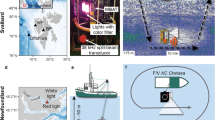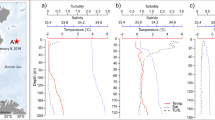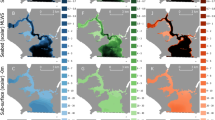Abstract
DURING the Swedish Deep-Sea Expedition with the Albatross, measurements of sub-surface radiation were carried out in different areas, chiefly by means of photo-electric methods. Special attention was given to the study of the biologically important short-wave part of the spectrum. The range beyond 315 mµ with anti-rachitic effects was determined by means of a special technique. Two liquid filters, namely, 18 mm. saturated nickel sulphate solution and 14 mm. picric acid solution (45 mgm. per litre), are used, together with a 6-mm. UG5 glass from Schott und Genossen. These filters are combined with a selenium rectifier cell adapted for the ultra-violet, the liquids being enclosed between three concentric hemispherical quartz shells around the cell covered by the UG5 glass. The centre of gravity for the measured radiation is estimated at 310 mµ. The photometer is connected to an Ising galvanometer with a sensitivity of 4 × 10−10 amp. per scale unit.
This is a preview of subscription content, access via your institution
Access options
Subscribe to this journal
Receive 51 print issues and online access
$199.00 per year
only $3.90 per issue
Buy this article
- Purchase on Springer Link
- Instant access to full article PDF
Prices may be subject to local taxes which are calculated during checkout
Similar content being viewed by others
References
Clarke and James, J. Opt. Soc. Amer., 29 (1939).
Johnson, Medd. Oceanografiska Inst., Göteborg, 8 (1946).
Kalle, Ann. Hydr. Mar. Met., 66 (1938).
Author information
Authors and Affiliations
Rights and permissions
About this article
Cite this article
JERLOV, N. Ultra-violet Radiation in the Sea. Nature 166, 111–112 (1950). https://doi.org/10.1038/166111a0
Issue Date:
DOI: https://doi.org/10.1038/166111a0
This article is cited by
-
Photobehaviors of the calanoid copepod Calanus sinicus from the Yellow Sea to visible and UV–B radiation as a function of wavelength and intensity
Journal of Oceanology and Limnology (2019)
-
UVA and UVB Penetration in the Water Column of a South West Atlantic Warm Temperate Estuary and its Effects on Cells and Fish Larvae
Estuaries and Coasts (2015)
-
Effects of UV radiation on the growth, photosynthetic and photoprotective components, and reproduction of the Caribbean shallow-water coral Porites furcata
Coral Reefs (2012)
-
Ultraviolet radiation and bio-optics in Crater Lake, Oregon
Hydrobiologia (2007)
Comments
By submitting a comment you agree to abide by our Terms and Community Guidelines. If you find something abusive or that does not comply with our terms or guidelines please flag it as inappropriate.



